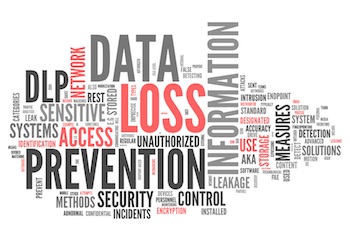Like leg warmers, data loss prevention (DLP) is back. Unlike leg warmers, DLP is actually cool, increasingly sophisticated, and something, to steal from Tim Gunn, companies will want to make work.
As the name implies, DLP is about preventing loss or misuse of data. By various means, including content discovery and analysis, it helps preclude end users from accidentally or maliciously sharing sensitive, critical, and confidential data that might put a business at risk. For instance, DLP enables administrators to set up policies (from a library of predefined content selectors) or, even, create custom rules to check outgoing emails (including attachments). If anything appears amiss, DLP can either quarantine emails for review, request users to modify data, or block emails and notify senders.

The concept isn’t a new one, but the ability to put it to use in an easier, more viable manner is.
DLP Making Headlines. Again.
Look at Google for Work. While Google’s been using tools for encryption, control sharing, mobile device management, and two-factor authentication to help secure email, they recently announced an additional layer of protection: DLP for Gmail. I mean, if Google’s hip to DLP, maybe it is time to take a closer look at this technology. Again.
Let’s revisit 2007, when DLP was first making headlines—in particular, with Symantec’s acquisition of promising DLP vendor Vontu. At the time, Vontu’s offering was thought to be the answer to augmenting other security products. Unfortunately, initial hopes were dashed when the product proved too complex for real-world practice.
Like water and electricity, people tend toward the path of least resistance. They like simplicity, and Vontu’s labor-benefit ratio wasn’t very appealing. The product’s default was insufficient (either too permissive or too restrictive) and led to too many false positives. Users lost track of what was real and what wasn’t. And while it was impossible to look at everything, the intricacy required to create filtering rules that ensured the right information got through and the right information stayed put was overwhelming.
You’re a Superstar. Yes, That’s What You Are.
Fast forward to 2016, and DLP’s resurrected en vogue status.
In its report, “The Data Loss Prevention Market by the Numbers: 2014-2019,” 451 Research predicts the DLP market to grow to $1.7B by 2019. Similarly, as revealed in its “Forecast Overview: Information Security, Worldwide, 3Q15 Update,” Gartner expects DLP to be among the fastest-growing security segments through 2019, with a combined annual growth rate of 9.9 percent.
Well DLP, don’t they love you? And why shouldn’t they?
When it works, DLP provides a range of business benefits, including compliance support and intellectual property protection. Today, thanks to increased compute power, the cloud, and advanced machine learning techniques, DLP solutions are faster at inspecting content, more accurate in building and tuning policies, and more efficient in managing policy violations. They also facilitate more automated benchmarking of what constitutes good and bad content, effectively diminishing false positives. It’s all about enabling companies not only to better understand where their data resides and how it’s being used, but to help control where it goes—or doesn’t.
Your DLP on a Security Delivery Platform
Another big advantage of today’s DLP is the option to deploy it on a Security Delivery Platform (SDP) rather than connect it directly to the network.
DLP’s inspection can be computationally intensive. It’s one thing to be checking attachment metadata to see if it’s a spreadsheet, but another to be looking through every email for phrases, formulas, and code that shouldn’t be leaving the network.
A Security Delivery Platform can prune out the applications—like video or Windows maintenance traffic—that the DLP doesn’t need to see or analyze. By retrieving traffic from everywhere in the network, including remote branch offices and virtualized network segments, a Security Delivery Platform gives an organization’s DLP a better chance at catching unwarranted data sharing. And most importantly, it makes the DLP hyper efficient by feeding it only relevant data, such as emails with attachments.
Moreover, there’s even the option to have some automation kick in. If another detection device, like an IPS or NAC, detects an anomaly, the DLP can, via APIs, instruct the Security Delivery Platform to start forwarding emails to the DLP for further inspection.
Imagine that. Your specialized security devices collaborating to prevent data exfiltration. How’s that for retro security cool?













